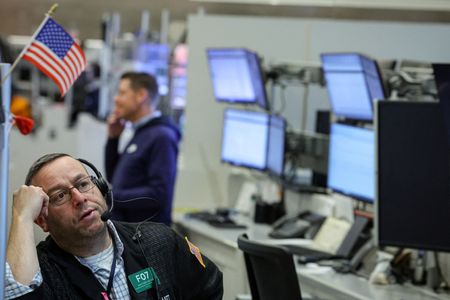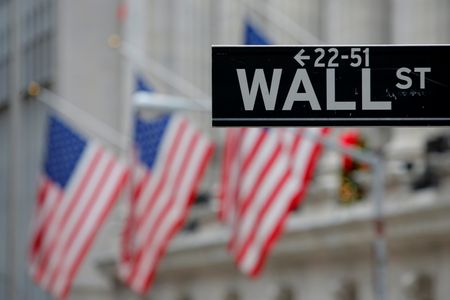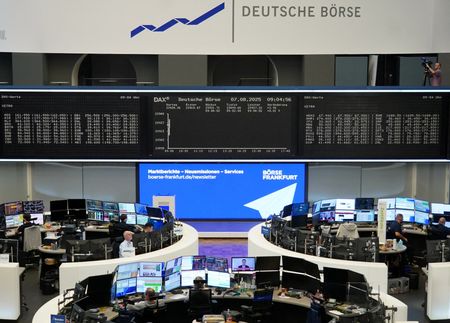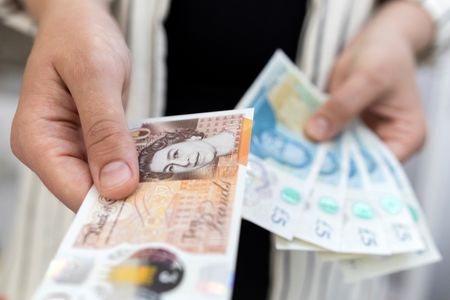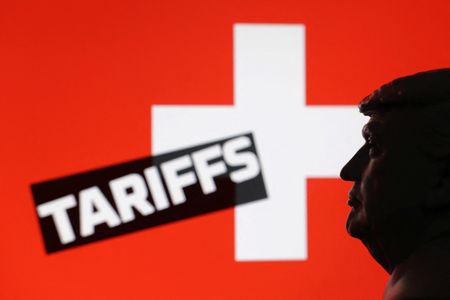By Naomi Rovnick, Yoruk Bahceli and Harry Robertson
LONDON (Reuters) -Big investors reeling from the shock of U.S. President Donald Trump’s hefty new tariffs are pulling out their global recession playbooks and rushing to diversify away from battered Wall Street stocks and the dollar.
Trump imposed heftier tariffs than investors expected on Wednesday, announcing a 10% baseline tariff on all imports, including 34% on China and 20% on the European Union, bringing the overall U.S. tariff level to its highest since 1910.
The question is to what extent the measures are a negotiating tactic, how much U.S. partners will retaliate and how fast tariff fallout feeds into economic pain.
Here’s a look at some markets in focus right now:
1/ RECESSION RISK
With tariffs set to hit economic growth and raising the odds for a global recession, it’s no surprise that traders are ramping up their central bank rate-cut bets.
They now see over 80 basis points (bps) of rate cuts from the Federal Reserve this year, versus closer to 70 bps before Trump’s announcement.
Even before Wednesday’s announcement, JPMorgan saw a 40% chance of a U.S. recession this year.
“We don’t know where those tariffs are going to end up, but it’s negative for global growth,” Columbia Threadneedle Investments CIO William Davies said.
2/ DOLLAR RATTLED
The U.S. dollar slid almost 2% percent against a basket of peers on Thursday, bringing its loss to over 6% so far this year with investors shunning it as a safe-haven for now.
“There’s a nervousness that everybody loses in terms of growth and the U.S. is one of the bigger losers,” said Societe Generale’s chief currency strategist Kit Juckes.
With Asian countries being hit with some of the highest tariffs, the dong in Vietnam, which will see a 46% levy, hit a record low.
But the euro surged above $1.10 and was set for its biggest one-day jump since 2015, despite hefty measures against the European Union.
Juckes said while the tariffs would hurt Europe’s economy in the near term, he was looking through that expecting stronger growth later, on the back of massive German stimulus and defence spending.
3/ NIGHTMARE ON WALL STREET
Wall Street shares have dropped 3.5% this year with futures trading on Thursday morning in New York signalling another 3% drop could occur in the next few hours.
“The US has been showing signs of weakness recently and there is nothing in what is going on now that will help it in the short and medium term,” Premier Miton CIO Neil Birrell said.
Overseas investors and retirement savers have ploughed $62 trillion into U.S. assets during a dizzying stock rally fuelled by artificial intelligence fever, which is now reversing.
Saxo global head of investment strategy Jacob Falkencrone added that the surge in the U.S. tariff rate was a tax on consumption and corporate costs, especially for industries relying on imports.
“The result? Higher prices, tighter margins, weaker growth—and a heightened risk of recession.”
4/ SPREAD THE PAIN
It’s not just U.S. stocks in the doldrums.
In Asia, Vietnamese stocks tumbled almost 7%, Japan’s Nikkei slid 3% to its lowest levels since an August rout, and European shares slid 2%.
Investors were now scouring the globe for assets that could be less exposed to trade and tariff shocks in the medium term.
State Street head of European investment strategy Altaf Kassam said “rolling uncertainty” was negative for global equities but that a euro zone recovery if U.S. tariffs were reduced via negotiations was a “wild card” trade.
Aberdeen portfolio manager Gabriel Sacks said Chinese stocks could bounce back because Beijing may now rapidly escalate its so-far piecemeal economic stimulus pledges in response to 54% tariffs, a level he said investors had previously feared.
“I’m relatively positive on China but you have to believe in policy starting to take effect and the property market stabilising,” Sacks said.
James Henderson at Janus Henderson Investors meanwhile saw opportunities in domestically focused UK stocks in sectors like food retail, which may have been hit by selling and after Britain will only see a 10% levy on exports.
5/ BACK TO SAFETY
While they have shunned the dollar, investors are still rushing to safe U.S. Treasuries. U.S. 10-year yields dropped more than 10 basis points to their lowest since October at 4.04%.
That’s a remarkable turnaround from January, when they surged to a more than one-year above 4.8%, as markets focused on heavy debt and deficit levels.
Marlborough chief investment officer Sheldon MacDonald said recession risks would “light a fire” under bond trades, adding he had moved out of U.S. stock markets to take a strong position in U.S., UK and German bonds.
But UBS head of European rates strategy Reinout De Bock added it was hard for the market to drive a “super-aggressive rally” in U.S. bonds when inflation was still high and could rise further, given uncertainty around the impact of tariffs on price growth.
(Reporting by Yoruk Bahceli, Naomi Rovnick and Harry Robertson, compiled by Yoruk Bahceli; graphics by Harry Robertson; editing by Dhara Ranasinghe)

